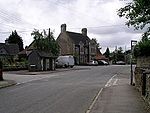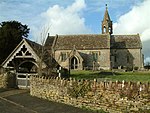RAF Hullavington
Military history of WiltshireMilitary parachuting in the United KingdomRoyal Air Force stations in WiltshireUse British English from May 2017

Royal Air Force Hullavington, or more simply RAF Hullavington, (ICAO: EGDV) was a Royal Air Force station located at Hullavington, near Chippenham, Wiltshire, England. The station opened in June 1937 and was primarily used for training. It closed on 31 March 1992 when it was transferred to the British Army and renamed Buckley Barracks. The airfield part of the site, known as Hullavington Airfield, continued to be used for RAF gliding operations until 2016 when it was sold to technology company Dyson.
Excerpt from the Wikipedia article RAF Hullavington (License: CC BY-SA 3.0, Authors, Images).RAF Hullavington
A429,
Geographical coordinates (GPS) Address Nearby Places Show on map
Geographical coordinates (GPS)
| Latitude | Longitude |
|---|---|
| N 51.525 ° | E -2.1333333333333 ° |
Address
Buckley Barracks
A429
SN14 6BS , Stanton St. Quintin
England, United Kingdom
Open on Google Maps








